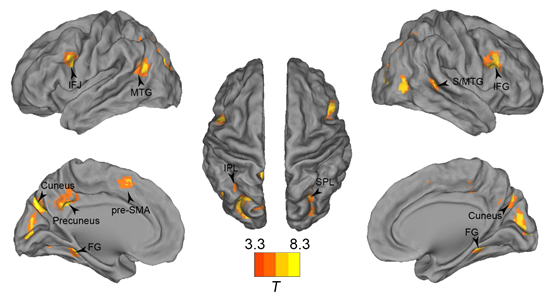近日,陈安涛教授团队在国际著名神经科学学术期刊Journal of Neuroscience上,与美国杜克大学心理与神经科学系Tobias Egner副教授合作发表题为“Dynamic trial-by-trial re-coding of task-set representations in frontoparietal cortex mediates behavioral flexibility”的研究论文,论文报道了该团队在认知控制灵活性的动态神经编码问题上取得的重要进展。西南大学心理学部博士生乔垒为论文第一作者,陈安涛教授为论文通讯作者。
认知控制被称为“心灵的指挥家”,调控着个体的各种目的性行为,在正常的生活和成功的工作中起着关键作用。认知控制的主要成分之一是认知灵活性,表现为个体在不同的任务集(task-sets)间灵活应对并转换的能力。在不同的任务集间转换会引起转换代价(switch cost),即转换任务的试次会比重复的试次有更长的反应时和更多的错误反应。前人的研究表明反应时上的转换代价是由克服前一个试次的残余激活的干扰以及构建并组织新的试次需要的时间共同决定的。此外,转换试次上更高的错误率暗示新形成的集合(set)比重复试次的集合(set)更不稳定。
然而,至今我们仍不清楚大脑如何动态响应并表征试次间任务集的灵活转换。一些多体素的fMRI 研究表明,额顶以及视觉皮层的激活模式能解码出当前正在应对的任务集,并且不同任务间的区分度会随着奖励或者训练而增加。这些研究认为额顶以及刺激加工脑区在表征不同任务集中起着重要作用,然而这些脑区是否支持试次到试次的动态任务集表征还无从知晓。该研究利用多体素模式分析(multivoxel pattern analysis; MVPA)和表征相似性分析(representational similarity analysis; RSA)来研究线索提示的任务转换。

图1,编码任务集(task-sets)表征的脑区
该研究发现,额顶和刺激加工脑区激活模式能够解码当前的任务集(图1);而且,在这些脑区上,重复试次比转换试次具有更高的分类准确率以及更远的样例到超平面(hyperplane)距离。进一步,该研究运用表征相似性方法调查了任务集在试次到试次之间的表征变化,发现重复试次比转换试次有更高的表征相似性,并且这种相似性的程度与行为指标显著相关:重复试次间高的相似性促进任务反应,而转换试次间高的相似性降低任务反应。最后,该研究采用表征相似性探索了任务集表征在试次内的转变,清晰地揭示了试次内从线索到目标阶段,转换试次中任务集的表征怎样远离上一个不相关的试次表征而更接近当前相关的试次表征(图2)。

图2,基于ROI的表征不相似性的预测模式(A)与实际观察模式(B)
该研究首次利用多体素模式分析和表征相似性的方法对任务集的在大脑的表征,以及任务集在试次间甚至试次内大脑的表征进行了研究,促进了我们对任务转换的神经机制的理解,对任务转换领域前人的研究提供有力的支持与验证,并且为该领域今后研究提供了新的思路与方法。研究结果对任务集重构 (task-set reconfiguration) 受任务集惰性 (task-set inertia) 这一假设提供了直接的神经证据,并且表明,额顶和刺激加工脑区能够以“动态自适应编码”方式灵活地表征不断变化的任务集。
该研究得到国家自然科学基金重点项目和中央高校基本科研业务费创新团队项目资助。
Lei Qiao, Lijie Zhang, Antao Chen*, and Tobias Egner (2017). Dynamic Trial-by-Trial Recoding of Task-Set Representations in the Frontoparietal Cortex Mediates Behavioral Flexibility. The Journal of Neuroscience
原文摘要:
Cognitive flexibility forms the core of humans’ extraordinary adaptability, but the precise neural mechanisms underlying our ability to nimbly shift between task-sets remain poorly understood. Recent functional magnetic resonance imaging (fMRI) studies employing multivoxel pattern analysis (MVPA) have shown that a currently relevant task-set can be decoded from activity patterns in frontoparietal cortex, but whether these regions support the dynamic transformation of task-sets from trial to trial is not clear. Here, we combined a cued task-switching protocol with human (both sexes) fMRI, and harnessed representational similarity analysis (RSA) to facilitate a novel assessment of trial-by-trial changes in neural task-set representations. We first used MVPA to define task-sensitive frontoparietal and visual regions and found that neural task-set representations on switch trials are less stably encoded than on repeat trials. We then exploited RSA to show that the neural representational pattern dissimilarity across consecutive trials is greater for switch than for repeat trials, and that the degree of this pattern dissimilarity predicts behavior. Moreover, the overall neural pattern of representational dissimilarities followed from the simple assumption that repeating sets results in stronger neural task representations than switching sets. Finally, when moving from cue to target phase within a trial, the pattern dissimilarities tracked the transformation from previous-trial task representations to the currently relevant set. These results provide neural evidence for the longstanding assumptions of an effortful task-set reconfiguration process hampered by task-set inertia, and they demonstrate that frontoparietal and stimulus processing regions support “dynamic adaptive coding”, flexibly representing changing task-sets in a trial-by-trial fashion.